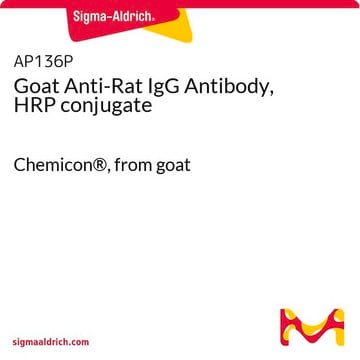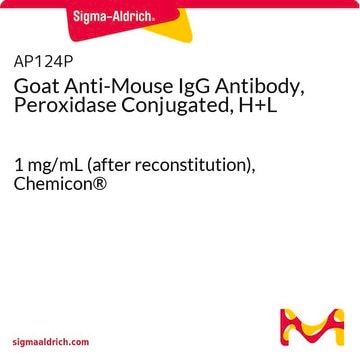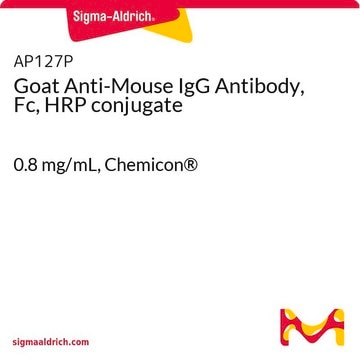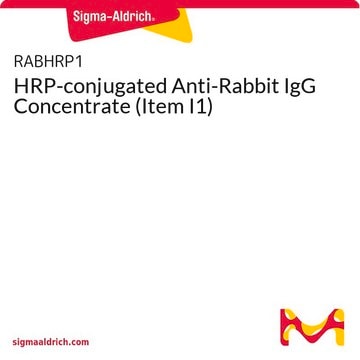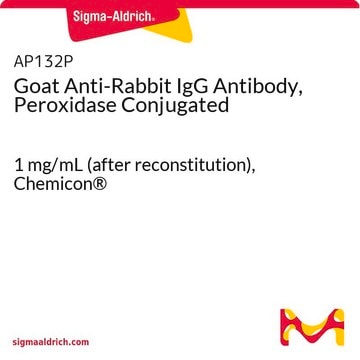AP156P
Goat Anti-Rabbit IgG Antibody, Fc, HRP conjugate
0.8 mg/mL, Chemicon®
Synonym(s):
Goat anti-Rabbit IgG
Sign Into View Organizational & Contract Pricing
All Photos(1)
About This Item
UNSPSC Code:
12352203
eCl@ss:
32160702
NACRES:
NA.46
Recommended Products
biological source
goat
Quality Level
conjugate
peroxidase conjugate
antibody form
F(ab′)2 fragment of affinity isolated antibody
antibody product type
secondary antibodies
clone
polyclonal
species reactivity
rabbit
manufacturer/tradename
Chemicon®
concentration
0.8 mg/mL
technique(s)
ELISA: suitable
western blot: suitable
shipped in
wet ice
target post-translational modification
unmodified
Related Categories
Specificity
Based on immunoelectrophoresis, the antibody reacts with the heavy chains on rabbit IgG but not with the light chains on most rabbit immunoglobulins. No antibody was detected against rabbit IgM, or against immunoglobulin serum proteins, but antibodies may cross-react with immunoglobulins from other species.
Application
ELISA and Western Blotting 1:5,000 - 1:100,000
Immunohistochemistry 1:500 - 1:5,000
Optimal working dilutions must be determined by the end user.
Immunohistochemistry 1:500 - 1:5,000
Optimal working dilutions must be determined by the end user.
Research Category
Secondary & Control Antibodies
Secondary & Control Antibodies
Research Sub Category
Fragment Specific Secondary Antibodies
Fragment Specific Secondary Antibodies
This Goat anti-Rabbit IgG Antibody, Fc, HRP conjugate is validated for use in ELISA, WB for the detection of Rabbit IgG.
Physical form
Liquid. Buffer =0.01M Sodium Phosphate, 0.25 M NaCl, pH 7.6, and mixed with 15mg/mL BSA as stabilizer containing no preservatives.
RECONSTITUTION:
Reconstitute in 2mL deionized water.
RECONSTITUTION:
Reconstitute in 2mL deionized water.
Storage and Stability
Maintain lyophilized product at 2-8°C for up to 12 months. After reconstitution the product is stable for several weeks at 2-8°C as an undiluted liquid. Use sterile technique as formulation has no preservatives. For extended storage after reconstitution, we suggest adding an equal volume of glycerol to make a final concentration of 50% glycerol followed by storage at -20°C, with or without aliquoting for up to 12 months. Please note the concentration of protein (and buffer salts) will decrease to one-half of the original after the addition of glycerol. Avoid repeated freeze/thaw cycles.
Legal Information
CHEMICON is a registered trademark of Merck KGaA, Darmstadt, Germany
Disclaimer
Unless otherwise stated in our catalog or other company documentation accompanying the product(s), our products are intended for research use only and are not to be used for any other purpose, which includes but is not limited to, unauthorized commercial uses, in vitro diagnostic uses, ex vivo or in vivo therapeutic uses or any type of consumption or application to humans or animals.
Not finding the right product?
Try our Product Selector Tool.
Storage Class Code
11 - Combustible Solids
WGK
WGK 3
Certificates of Analysis (COA)
Search for Certificates of Analysis (COA) by entering the products Lot/Batch Number. Lot and Batch Numbers can be found on a product’s label following the words ‘Lot’ or ‘Batch’.
Already Own This Product?
Find documentation for the products that you have recently purchased in the Document Library.
Customers Also Viewed
Kimie Date et al.
Scientific reports, 11(1), 12023-12023 (2021-06-10)
Vitronectin (VN) is a glycoprotein found in extracellular matrix and blood. Collagen, a major extracellular matrix component in mammals, is degraded by cathepsin K (CatK), which is essential for bone resorption under acidic conditions. The relationship between VN and cathepsins
Kimie Date et al.
FEBS open bio, 9(4), 755-768 (2019-04-16)
Liver cirrhosis (LC) is a disease characterized by pathological accumulation and alteration of extracellular matrix (ECM) proteins; the interaction between two such proteins, collagen and vitronectin (VN), is considered to be the key to controlling ECM remodeling in liver cirrhosis.
Human cytomegalovirus major immediate early 1 protein targets host chromosomes by docking to the acidic pocket on the nucleosome surface.
Mucke, K; Paulus, C; Bernhardt, K; Gerrer, K; Schon, K; Fink, A; Sauer et al.
Journal of virology null
Hai-Ping Zhu et al.
Molecular medicine reports, 21(4), 1872-1880 (2019-09-24)
Lipopolysaccharide (LPS) induces stress inflammation and apoptosis. Pulmonary epithelial cell apoptosis, which accelerates the progression of acute lung injury (ALI)/acute respiratory distress syndrome (ARDS), is the leading cause of mortality in patients with ALI/ARDS. The nephroblastoma overexpressed protein (CCN3), an
Jia Meng Xu et al.
The New phytologist, 225(4), 1732-1745 (2019-10-15)
The mechanisms involved in the regulation of gene expression in response to phosphate (Pi) deficiency have been extensively studied, but their chromatin-level regulation remains poorly understood. We examined the role of histone acetylation in response to Pi deficiency by using
Our team of scientists has experience in all areas of research including Life Science, Material Science, Chemical Synthesis, Chromatography, Analytical and many others.
Contact Technical Service
